
Tordesillas
Encyclopedia
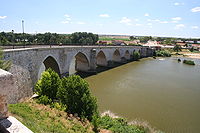
Municipality
A municipality is essentially an urban administrative division having corporate status and usually powers of self-government. It can also be used to mean the governing body of a municipality. A municipality is a general-purpose administrative subdivision, as opposed to a special-purpose district...
in the province of Valladolid, Castile and León
Castile and León
Castile and León is an autonomous community in north-western Spain. It was so constituted in 1983 and it comprises the historical regions of León and Old Castile...
, central Spain
Spain
Spain , officially the Kingdom of Spain languages]] under the European Charter for Regional or Minority Languages. In each of these, Spain's official name is as follows:;;;;;;), is a country and member state of the European Union located in southwestern Europe on the Iberian Peninsula...
.
It is located 25 km southwest of the provincial capital, Valladolid
Valladolid
Valladolid is a historic city and municipality in north-central Spain, situated at the confluence of the Pisuerga and Esgueva rivers, and located within three wine-making regions: Ribera del Duero, Rueda and Cigales...
at an elevation of 704 meters. The population was c. 9,000 in 2009.
Tordesillas is located on the Duero River, but the river is not navegable up to Tordesillas. There are excellent highway connections (a four-lane freeway) with Madrid
Madrid
Madrid is the capital and largest city of Spain. The population of the city is roughly 3.3 million and the entire population of the Madrid metropolitan area is calculated to be 6.271 million. It is the third largest city in the European Union, after London and Berlin, and its metropolitan...
, 182 km to the southeast, and with Salamanca
Salamanca
Salamanca is a city in western Spain, in the community of Castile and León. Because it is known for its beautiful buildings and urban environment, the Old City was declared a UNESCO World Heritage Site in 1988. It is the most important university city in Spain and is known for its contributions to...
, 96 km to the southwest. The provincial capital is also linked by four-lane highway. There are railroad connections with Salamanca, Orense, Madrid, and Valladolid.
Because of its important highway connections Tordesillas has become a major transit hub. The economy is based on services — especially connected to tourism — and the agricultural production of the surrounding area. Wheat has long been the traditional agricultural product.
The town is well served by hotels with a parador
Parador
A parador , in Spain and other Spanish-speaking countries, is a kind of luxury hotel, usually located in a historic building such as a monastery or castle. Parar means to stop, halt or stay.- Paradores de Turismo de España :...
, four three-star hotels, one two-star hotel, and 10 hostal
Hostal
A hostal is a type of lodging found mostly in Spain and Hispanic America. Hostales tend to be cheaper than hotels. They normally have a bar and/or a restaurant/cafeteria where drinks and food are sold to guests and locals alike....
s and pension
Pension (lodging)
A pensione is a family-owned guest house or boarding house. This term is typically used in Portugal, France, Spain, Italy, other Continental European countries, in areas of North Africa and the Middle East that formerly had large European expatriate populations, and in some parts of South America...
s. There is also a camping site. There is also an abundance of restaurants — 27 in total — with the Parador restaurant having a three fork classification.
North of the town there is a fertile valley formed by the Duero, with extensive use of irrigation by central pivots.
History
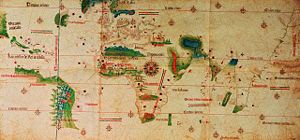
Alfonso X of Castile
Alfonso X was a Castilian monarch who ruled as the King of Castile, León and Galicia from 1252 until his death...
the Wise. The town began to be favored by the royal family and nobility, above all after Alfonso XI
Alfonso XI of Castile
Alfonso XI was the king of Castile, León and Galicia.He was the son of Ferdinand IV of Castile and his wife Constance of Portugal. Upon his father's death in 1312, several disputes ensued over who would hold regency, which were resolved in 1313...
built a palace (1325). In the 15th century the town hosted several meetings of the Cortes. During the skirmishes between Henry IV
Henry IV of Castile
Henry IV , King of the Crown of Castile, nicknamed the Impotent , was the last of the weak late medieval kings of Castile...
and the nobility the city supported the monarchy, and again during the clashes between the Catholic Monarchs
Catholic Monarchs
The Catholic Monarchs is the collective title used in history for Queen Isabella I of Castile and King Ferdinand II of Aragon. They were both from the House of Trastámara and were second cousins, being both descended from John I of Castile; they were given a papal dispensation to deal with...
and Joanna La Beltraneja in 1476.
The Catholic Monarchs signed the Treaty of Tordesillas
Treaty of Tordesillas
The Treaty of Tordesillas , signed at Tordesillas , , divided the newly discovered lands outside Europe between Spain and Portugal along a meridian 370 leagueswest of the Cape Verde islands...
with the Portuguese crown in 1494, which established the line dividing the globe between Spain and Portugal for colonization purposes. This especially affected the Portuguese and Spanish colonization of the Americas
Spanish colonization of the Americas
Colonial expansion under the Spanish Empire was initiated by the Spanish conquistadores and developed by the Monarchy of Spain through its administrators and missionaries. The motivations for colonial expansion were trade and the spread of the Christian faith through indigenous conversions...
, and placed the name Tordesillas worldwide into history's use since.
Despite Tordesillas' traditional support for the monarchy, in the Castilian War of the Communities
Castilian War of the Communities
The Revolt of the Comuneros was an uprising by citizens of Castile against the rule of Charles V and his administration between 1520 and 1521. At its height, the rebels controlled the heart of Castile, ruling the cities of Valladolid, Tordesillas, and Toledo.The revolt occurred in the wake of...
by citizens of Castile against the rule of Charles V
Charles V, Holy Roman Emperor
Charles V was ruler of the Holy Roman Empire from 1519 and, as Charles I, of the Spanish Empire from 1516 until his voluntary retirement and abdication in favor of his younger brother Ferdinand I and his son Philip II in 1556.As...
, the city took the side of the Comuneros. The leaders chose Charles' own mother, Queen Joanna I
Joanna of Castile
Joanna , nicknamed Joanna the Mad , was the first queen regnant to reign over both the Crown of Castile and the Crown of Aragon , a union which evolved into modern Spain...
, as an alternative ruler in more than title in 1519. They came to the town to ask for the mediation of Joanna I, confined within the Santa Clara convent since 1509 by her father Ferdinand II
Ferdinand II of Aragon
Ferdinand the Catholic was King of Aragon , Sicily , Naples , Valencia, Sardinia, and Navarre, Count of Barcelona, jure uxoris King of Castile and then regent of that country also from 1508 to his death, in the name of...
. However in 1521, after nearly a year of rebellion, the reorganized supporters of the emperor Charles V struck a crippling blow to the comuneros at the Battle of Villalar
Battle of Villalar
The Battle of Villalar was a battle in the Revolt of the Comuneros fought on April 23, 1521 near the town of Villalar in Valladolid province, Spain. The royalist supporters of King Charles I won a crushing victory over the comuneros rebels. Three of the most important rebel leaders were...
, and finally royal troops of the Count of Haro captured Tordesillas.
This 16th century event was the beginning of a long decline from influence and prosperity. The ongoing position of Tordesillas at a crossing of historic roads and modern highways has been the decisive factor in its economic survival and development.
Convent of Santa Clara
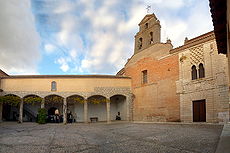
Alfonso XI of Castile
Alfonso XI was the king of Castile, León and Galicia.He was the son of Ferdinand IV of Castile and his wife Constance of Portugal. Upon his father's death in 1312, several disputes ensued over who would hold regency, which were resolved in 1313...
as his palace
Palace
A palace is a grand residence, especially a royal residence or the home of a head of state or some other high-ranking dignitary, such as a bishop or archbishop. The word itself is derived from the Latin name Palātium, for Palatine Hill, one of the seven hills in Rome. In many parts of Europe, the...
in 1344. His son Peter the Cruel had it embellished by Mudéjar artists, beautiful works at Santa Clara, though on a much smaller scale than they did in the Alcázar of Seville. The facade, a lovely small patio, a chapel and the baths remain of Peter the Cruel's palace. Blanche de Bourbon was held here after her abandonment by Peter for María de Padilla in 1353. The former portal, blocked off now, has a particularly fine Mudéjar doorway. In 1363 he ceded Santa Clara to two of his daughters by María de Padilla. They turned it into a convent
Convent
A convent is either a community of priests, religious brothers, religious sisters, or nuns, or the building used by the community, particularly in the Roman Catholic Church and in the Anglican Communion...
, but it retained its role as a royal palace.
In 1420 the Infante Don Enrique of Aragón burst into the palace and seized the person of John II, who escaped the Infante thanks to Álvaro de Luna.
Queen Joanna's confinement
Santa Clara convent's saddest association is with Joanna I, Queen of CastileJoanna of Castile
Joanna , nicknamed Joanna the Mad , was the first queen regnant to reign over both the Crown of Castile and the Crown of Aragon , a union which evolved into modern Spain...
and Aragon
Crown of Aragon
The Crown of Aragon Corona d'Aragón Corona d'Aragó Corona Aragonum controlling a large portion of the present-day eastern Spain and southeastern France, as well as some of the major islands and mainland possessions stretching across the Mediterranean as far as Greece...
, the daughter of Isabella I of Castile
Isabella I of Castile
Isabella I was Queen of Castile and León. She and her husband Ferdinand II of Aragon brought stability to both kingdoms that became the basis for the unification of Spain. Later the two laid the foundations for the political unification of Spain under their grandson, Charles V, Holy Roman Emperor...
and Ferdinand II of Aragon
Ferdinand II of Aragon
Ferdinand the Catholic was King of Aragon , Sicily , Naples , Valencia, Sardinia, and Navarre, Count of Barcelona, jure uxoris King of Castile and then regent of that country also from 1508 to his death, in the name of...
. She ascended the Castilian throne as Princess of Asturias
Prince of Asturias
Prince of Asturias is the historical title given to the heir to the Spanish throne. It was also the title under the earlier Kingdom of Castile. The current Prince of Asturias is Felipe, son of King Juan Carlos of Spain and Queen Sofía...
in 1502 and succeeded her mother as Queen regnant
Queen regnant
A queen regnant is a female monarch who reigns in her own right, in contrast to a queen consort, who is the wife of a reigning king. An empress regnant is a female monarch who reigns in her own right over an empire....
of Castile in 1504. Joanna's life with her husband Philip I of Castile
Philip I of Castile
Philip I , known as Philip the Handsome or the Fair, was the first Habsburg King of Castile...
was rendered extremely unhappy by his infidelity and political insecurity, during which he consistently attempted to usurp her legal birthrights of power. This led in great part to the rumors of her insanity due to reports of depressive or neurotic acts committed while she was being imprisoned or coerced by her husband; most historians now agree she was merely clinically depressed or schizophrenic at the time, not 'insane
Insanity
Insanity, craziness or madness is a spectrum of behaviors characterized by certain abnormal mental or behavioral patterns. Insanity may manifest as violations of societal norms, including becoming a danger to themselves and others, though not all such acts are considered insanity...
' as commonly believed. His early death in 1506 added the pressures of her father now maneuvering to block her legal birthrights of power and sole rule. He succeeded, and as Regent ordered his daughter confined within the Convent of Santa Clara in 1509.
Here she received her son Charles I after his arrival in Spain in 1517 from Flanders
Flanders
Flanders is the community of the Flemings but also one of the institutions in Belgium, and a geographical region located in parts of present-day Belgium, France and the Netherlands. "Flanders" can also refer to the northern part of Belgium that contains Brussels, Bruges, Ghent and Antwerp...
. Charles had landed on the Asturian coast in September and it took six weeks for the royal entourage to reach Tordesillas. He had become co-monarch of Castile
Crown of Castile
The Crown of Castile was a medieval and modern state in the Iberian Peninsula that formed in 1230 as a result of the third and definitive union of the crowns and parliaments of the kingdoms of Castile and León upon the accession of the then King Ferdinand III of Castile to the vacant Leonese throne...
and Aragon
Crown of Aragon
The Crown of Aragon Corona d'Aragón Corona d'Aragó Corona Aragonum controlling a large portion of the present-day eastern Spain and southeastern France, as well as some of the major islands and mainland possessions stretching across the Mediterranean as far as Greece...
with his mother, after the regent period and Ferdinand II's death in 1519. Charles continued her imprisonment until she died in 1555, after being confined nearly fifty years inside Santa Clara. The fact that Juana remained, on record, the legitimate Queen regnant
Queen regnant
A queen regnant is a female monarch who reigns in her own right, in contrast to a queen consort, who is the wife of a reigning king. An empress regnant is a female monarch who reigns in her own right over an empire....
of Castile and Aragon until her death must have caused Charles at least some disquiet. His chambers at the monastery of Yuste
Yuste
Yuste Monastery is in the small village now called Cuacos de Yuste in the province of Cáceres in the autonomous community of Extremadura, Spain...
(Cáceres) to which he retired on his abdication of the Spanish and Holy Roman Emperor
Charles V, Holy Roman Emperor
Charles V was ruler of the Holy Roman Empire from 1519 and, as Charles I, of the Spanish Empire from 1516 until his voluntary retirement and abdication in favor of his younger brother Ferdinand I and his son Philip II in 1556.As...
crowns in 1556, a year after her death in Tordesillas, were and still are hung in black in her memory. The exact windowless rooms of her confinement are unknown, however in one room her little clavichord has been preserved.
Plaza Mayor and churches
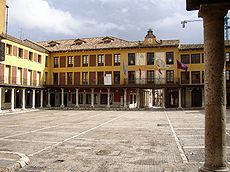
Colonnade
In classical architecture, a colonnade denotes a long sequence of columns joined by their entablature, often free-standing, or part of a building....
and portico
Portico
A portico is a porch leading to the entrance of a building, or extended as a colonnade, with a roof structure over a walkway, supported by columns or enclosed by walls...
s creating the arcade
Arcade (architecture)
An arcade is a succession of arches, each counterthrusting the next, supported by columns or piers or a covered walk enclosed by a line of such arches on one or both sides. In warmer or wet climates, exterior arcades provide shelter for pedestrians....
that encircles it.
Nearby is the Church of Santa Maria, built from the sixteenth to the eighteenth centuries. It has a monumental baroque
Baroque
The Baroque is a period and the style that used exaggerated motion and clear, easily interpreted detail to produce drama, tension, exuberance, and grandeur in sculpture, painting, literature, dance, and music...
sacristy
Sacristy
A sacristy is a room for keeping vestments and other church furnishings, sacred vessels, and parish records.The sacristy is usually located inside the church, but in some cases it is an annex or separate building...
. The town's other landmark churches are San Juan, San Pedro, Santiago, and San Antolín.
The massive 15th-century Church of San Antolín is of special interest, containing a museum
Museum
A museum is an institution that cares for a collection of artifacts and other objects of scientific, artistic, cultural, or historical importance and makes them available for public viewing through exhibits that may be permanent or temporary. Most large museums are located in major cities...
of religious art
Sacred art
Sacred art is imagery intended to uplift the mind to the spiritual. Sacred art involves the ritual and cultic practices and practical and operative aspects of the path of the spiritual realization within the bosom of the tradition in question....
collected from churches in the vicinity. The spacious church interior has a single nave
Nave
In Romanesque and Gothic Christian abbey, cathedral basilica and church architecture, the nave is the central approach to the high altar, the main body of the church. "Nave" was probably suggested by the keel shape of its vaulting...
, and its most outstanding feature is the sumptuous Alderete Chapel, containing the 1550 alabaster
Alabaster
Alabaster is a name applied to varieties of two distinct minerals, when used as a material: gypsum and calcite . The former is the alabaster of the present day; generally, the latter is the alabaster of the ancients...
tomb of Don Pedro de Alderete, Commander of the Order of Santiago
Order of Santiago
The Order of Santiago was founded in the 12th century, and owes its name to the national patron of Galicia and Spain, Santiago , under whose banner the Christians of Galicia and Asturias began in the 9th century to combat and drive back the Muslims of the Iberian Peninsula.-History:Santiago de...
.
There are also two other historic convents besides Santa Clara in Tordesillas — Convento de Carmelo and Convento de San Francisco.
Festivals
The Main Feasts in Tordesillas are held in September although the date is variable every year.Festivities in honour of 'La Virgen de La Peña'
The celebrations are in honour of Our Lady 'La Virgen de la Peña', (Our Lady of Sorrow) Patron Saint of the Village and Land of Tordesillas. Her hermitage is located on the other side of the river, where people arrive for the romería (pilgrimage) in carts drawn by decorated horses.Celebrations begin on 8 September, Patron Saint's Day of Tordesillas, the 'Virgen de la Guía' (Our Guiding Lady).
Following Saturday to the 8th of September is called "Sábado de Faroles". (The Saturday of torchs or lanterns made of wood). During the night there is the "Desfile de Faroles", a big parade where each competing "peña" (crew or team) carries a "farol" (which is somewhat bigger than a common streetlamp). Each side of the "farol" is painted with typical images about Tordesillas and about the festivities. Crews, accompanied by brass bands, take part in the parade carrying their "faroles", along the streets of the village. The crew judged to have the most beautiful farole is awarded a prize.
The guards' patrol through the old walls of Tordesillas gave rise to this curious celebration that traverses the whole village.
Torneo del Toro de la Vega
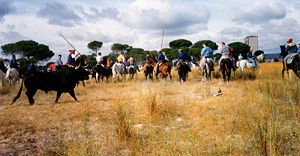
The toro (bull) to be killed is driven by horsemen wielding spears across the bridge from the town to a meadow (vega). Only when it reaches the meadow across the river is it finally allowed to receive a lethal lance from one of many competing lancers pursuing the much debilitated animal on foot. During the run (corrida) lancers are only permitted to wound the beast. The person who finally delivers the fatal blow is entitled to cut off the beast's testicles parade them through the town impaled on the tip of his spear. The City then awards him a gold medal and a commemorative forged iron spear.
This is a form of killing an animal which has been denounced by animal rights groups for the especially prolonged process of slaughter involving terrifying horses, crowds and very many wounds.

